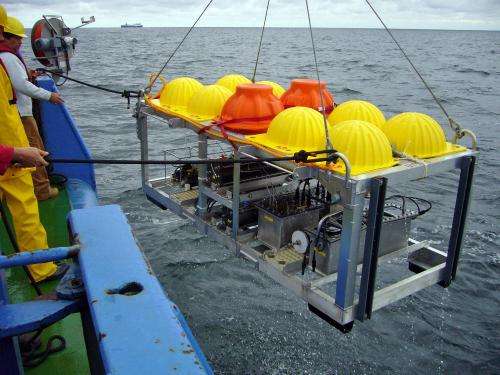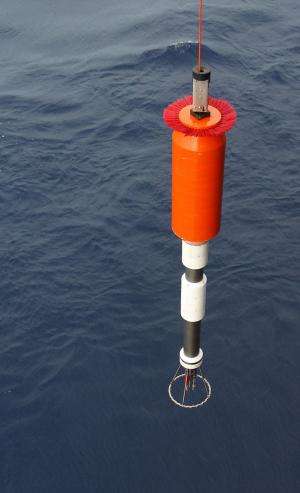Decoding material fluxes in the tropical ocean

How is vital oxygen supplied to the tropical ocean? For the first time, oceanographers at GEOMAR Helmholtz Centre for Ocean Research Kiel were able to make quantitative statements regarding this question. They showed that about one third of the oxygen supply in these areas is provided by turbulent processes, such as eddies or internal waves. The study, conducted in the framework of the Collaborative Research Center SFB 754 "Climate-Biogeochemistry Interactions in the Tropical Ocean", was just published in the international journal Biogeosciences.
In many areas of the tropical oceans, oxygen is in rather short supply. In the Indian Ocean, the eastern Pacific and the Atlantic Ocean off the coast of West Africa, at depths of several hundred meters, there are vast areas with very low oxygen levels, so-called oxygen minimum zones (OMZ). These have been the focus of scientists in Kiel for a number of years. Using modern measurement techniques, they were now able to quantify for the first time which of the processes are important for the oxygen supply to these areas, the so-called ventilation. Thus far, oceanographers had assumed that the dissolved oxygen in the ocean would slowly penetrate from the surface layers to greater depths through large-scale processes. Fluctuations in the trade winds driving the ocean currents could thus regulate the oxygen supply directly. However, measurements off the coast of West Africa and south of the Cape Verde islands have now revealed the major importance of turbulent mixing processes. The scientists used high-precision measurements, such as microstructure probes and profiling current meters, for their investigations.
The surveying of a so-called tracer, a chemically inert substance discharged into the ocean, confirmed the results of the direct turbulence measurements. The horizontal and vertical spreading of the tracer was determined by chemical analysis with a high degree of accuracy over a period of three years.

Both measurement methods showed that about one third of the oxygen supply in the tropical oxygen minimum zones is provided by the vertical turbulent mixing. "The relatively high contribution of turbulence to the oxygen budget has surprised us," says Prof. Dr. Martin Visbeck, one of the initiators of the experiment. "Also, thanks to the improved measurement methods and accuracies, we were breaking new ground here," Visbeck continued. First author Dr. Tim Fischer, who - as part of his doctorate – was able to significantly improve the parameters settings and evaluation of ship-based current profile measurements to determine the turbulence in the ocean from a moving ship, adds: "Thus, in comparison to the time-consuming microstructure probe measurements, we are able to collect much more data." Co-author Dr. Donata Banyte from GEOMAR, who – as part of her dissertation - has worked for more than three years with the data from the tracer experiment, adds: "I am delighted to have discovered something really new and important in physical oceanography".
"Since any expansion of oxygen deficient areas can have negative effects on the marine ecosystem, it is important to identify the relevant processes thereof. The results will help us to better understand the dynamics and changes in the oxygen minimum zones in the oceans," says Prof. Visbeck.
More information: Fischer, T., D. Banyte, P. Brandt, M. Dengler, G. Krahmann, T. Tanhua, and M. Visbeck, 2013: Diapycnal oxygen supply to the tropical North Atlantic oxygen minimum zone. Biogeosciences, 10, 5079-5093, doi:10.5194/bg-10-5079-2013
Journal information: Biogeosciences
Provided by Helmholtz Association of German Research Centres




















